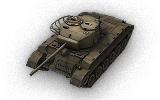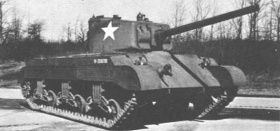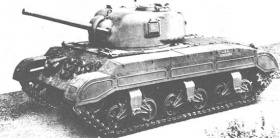T23
| Revision as of 12:07, 21 February 2011 Photos added | Revision as of 13:33, 21 February 2011 Text updated | |||
| Line 49: | Line 49: | |||
| This experimental medium tank was developed from the end of 1942 through the Summer of 1944. The T23T80 was neither adopted for serial production nor took part in combat. | This experimental medium tank was developed from the end of 1942 through the Summer of 1944. The T23T80 was neither adopted for serial production nor took part in combat. | |||
| ? | + | First T23 prototypes were completed in January 1943, and these vehicle were the first to be completed in the T20 series. They differed from the other T20 series in using the electric drive transmission manufactured by General Electric. They were also fitted with the vertical volute spring suspension similar to that used on the Medium M4 Tank. The armament consisted of the 76mm Ml gun. As with the T20 and T22 series, projects were initiated for development of vehicles armed with the 75mm automatic and 3in guns. Designated T23EI and T23E2 respectively, these projects were cancelled without development. After tests of the pilot vehicle T23, production was authorised for 250 of these vehicles. The production model differed in several ways from the pilot vehicle: 76mm Ml gun was replaced with model M1A1, a vision cupola was provided for the commander, and the gun ring hatch mounting the .50 calibre AA machine-gun was moved to the loader's position. Production commenced in November 1943 and continued through to December 1944, but none were shipped overseas. Though this vehicle did not see active service, features tried and developed in the T20-T23 series were incorporated into M4 vehicles, in particular the T23 type turret and 76mm gun, HVSS and the simplified 47° hull front. Research work on these vehicles also played a big part in the development of the T25 and T26 Medium Tanks. | ||
| + | ||||
| [[image:T-22E1 prototype vehicle..jpg|thumb|280px|right|T-22E1 prototype vehicle]] | [[image:T-22E1 prototype vehicle..jpg|thumb|280px|right|T-22E1 prototype vehicle]] | |||
| ? | ||||
| }} | }} | |||
Revision as of 13:33, 21 February 2011
T23
| USA | Medium Tank | Tier VIII |
| Cost | 2,103,000 credits |
|---|---|
| Health | 1,310 |
| Weight/Load Limit | 35.21/36.14t |
| Engine Power | 560hp |
| Speed Limit | 56km/h |
| Traverse Speed | 37deg/s |
| Hull Armor | 76/50/38mm |
| Turret Armor | 89/63/63mm |
| Damage | 86-144HP |
| Penetration | 96-160mm |
| Rate of Fire | 16.22r/m |
| Accuracy | 0.38m |
| Aim time | 2s |
| Turret Traverse | 43deg/s |
| Gun Traverse Arc | gunTraverseArc |
| Gun Vertical Limits | gunVerticalLimits |
| Ammo Capacity | ammo |
| Chance of Fire | 25% |
| View Range | 430m |
| Signal Range | 450m |
| Parent | parent |
| Child | child |

The T23 is the tier 8 American medium tank. Fast and maneuverable, this tank handles similarly to the T20, but can reach higher top speeds and turn more quickly. Like all American medium tanks, its main weakness is its lack of armor. In addition, the 90mm gun begins to lose its punch against the heavier opponents the T23 faces, when compared to the T20, giving it sub-par firepower for its tier. However, the 90mm still has good penetration, rate-of-fire, and accuracy, so the T23's increased mobility can still put it to good use. Mobility is the T23's best strength, and operates wonderfully in a medium tank wolf-pack. Research leads to the M26 Pershing.
Modules
|
Historical Info
This experimental medium tank was developed from the end of 1942 through the Summer of 1944. The T23T80 was neither adopted for serial production nor took part in combat.
First T23 prototypes were completed in January 1943, and these vehicle were the first to be completed in the T20 series. They differed from the other T20 series in using the electric drive transmission manufactured by General Electric. They were also fitted with the vertical volute spring suspension similar to that used on the Medium M4 Tank. The armament consisted of the 76mm Ml gun. As with the T20 and T22 series, projects were initiated for development of vehicles armed with the 75mm automatic and 3in guns. Designated T23EI and T23E2 respectively, these projects were cancelled without development. After tests of the pilot vehicle T23, production was authorised for 250 of these vehicles. The production model differed in several ways from the pilot vehicle: 76mm Ml gun was replaced with model M1A1, a vision cupola was provided for the commander, and the gun ring hatch mounting the .50 calibre AA machine-gun was moved to the loader's position. Production commenced in November 1943 and continued through to December 1944, but none were shipped overseas. Though this vehicle did not see active service, features tried and developed in the T20-T23 series were incorporated into M4 vehicles, in particular the T23 type turret and 76mm gun, HVSS and the simplified 47° hull front. Research work on these vehicles also played a big part in the development of the T25 and T26 Medium Tanks.
| Light Tanks | T1 Cunningham • M2 Light Tank • T1E6 • T2 Light Tank • T7 Combat Car • M22 Locust • M3 Stuart • MTLS-1G14 • M5 Stuart • M24 Chaffee • T21 • T71 |
| Medium Tanks | T2 Medium Tank • M2 Medium Tank • M3 Lee • M4 Sherman • M4A2E4 Sherman • M7 • Ram II • M4A3E2 Sherman Jumbo • M4A3E8 Sherman • T20 • M26 Pershing • T23 • T26E4 Super Pershing • T69 • M46 Patton • T54E1 • M48A1 Patton • M60 |
| Heavy Tanks | T1 Heavy Tank • T14 • M6 • T29 • M6A2E1 • T32 • T34 • M103 • T57 Heavy Tank • T110E5 |
| Tank Destroyers | T18 • T82 • M8A1 • T40 • M10 Wolverine • T49 • M18 Hellcat • M36 Jackson • T25 AT • T25/2 • T28 • T28 Prototype • T30 • T95 • T110E3 • T110E4 |
| Self-Propelled Guns | T57 • M7 Priest • M37 • M41 • M44 • M12 • M40/M43 • M53/M55 • T92
|






